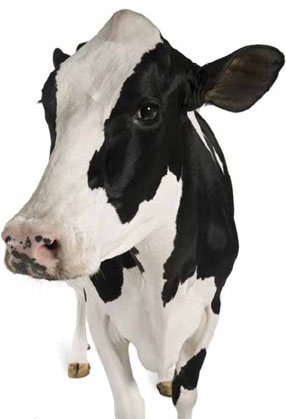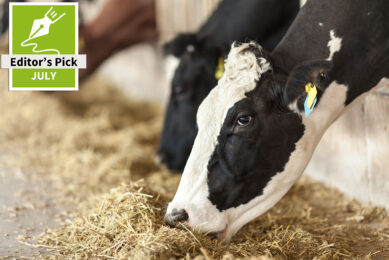Optimal liver support for a healthy cow during transition

During early lactation, most dairy cows do not consume enough feed to maintain high demands for milk production.This period of negative energy balance often leads to the development of fatty livers – a condition that can be minimised by adding liver stimulating nutrients to the cow’s diet, explains Sander Abrahamse, product manager ruminants at Provimi.
By Emmy Koeleman
Energy demands for milk yield in early lactation are extremely high in modern dairy cows and the animals are constantly on edge. Diseases such as ketosis, milk fever and metritis are therefore constantly lying in wait. The problems all seem to start with a negative energy balance during the transition period. Especially during the early lactation, the cow needs a lot of energy for milk production but the increase in dry matter intake (DMI) lags behind the increase in energy demands (Figure 1). This is not only the case in high productive dairy cows but also when quality of available feed is poor during the start of the lactation. Already on the 4thday of lactation, when milk yield increases, dairy cows need three times more glucose, two times more amino acids and four times the normal fatty acid supplementation in comparison to the requirement of a pregnant cow at the end of the dry period. Cows can mobilise more than 1kg per day of body fat to compensate for this energy shortage. This body fat needs to be metabolised in the liver in order to supply energy. But this extensive mobilisation of body fat in high yielding cows puts a lot of pressure on the liver, which may lead to the development of fatty liver and reduce the heath status and milk performance of the cow.
Improve energy metabolism
Being aware of the needs that the dairy cow has during her dry and transition period can substantially reduce the risk of transition cows falling prey to developing a fatty liver. An important issue is to make sure the cow gets enough energy through increased feed intake. A high energy intake around calving may be obtained by increasing the energy density of the diet, and by optimising nutritional management (TMR). The energy intake can be optimised by using high quality feeds in a comfortable environment, or the use of quickly fermentable carbohydrates. The latter strategy however causes increased risk of rumen acidosis. Bypass fat is a better solution to increase energy intake due to its high energy level without the risk of rumen acidosis. Energy-related health issues during the transition period can also be minimised by drying off cows at a recommended body condition score of 2.5-3.0. The cow’s body condition in late lactation and during the dry period should be monitored to ensure that the cow is not over-conditioned. During the dry period the cow should not lose or gain more than 0.5 body condition.
Being aware of the needs that the dairy cow has during her dry and transition period can substantially reduce the risk of transition cows falling prey to developing a fatty liver. An important issue is to make sure the cow gets enough energy through increased feed intake. A high energy intake around calving may be obtained by increasing the energy density of the diet, and by optimising nutritional management (TMR). The energy intake can be optimised by using high quality feeds in a comfortable environment, or the use of quickly fermentable carbohydrates. The latter strategy however causes increased risk of rumen acidosis. Bypass fat is a better solution to increase energy intake due to its high energy level without the risk of rumen acidosis. Energy-related health issues during the transition period can also be minimised by drying off cows at a recommended body condition score of 2.5-3.0. The cow’s body condition in late lactation and during the dry period should be monitored to ensure that the cow is not over-conditioned. During the dry period the cow should not lose or gain more than 0.5 body condition.
Liver stimulation
Besides the above mentioned measures to reduce the chances for developing fatty livers in the herd, feed additives to target the problem are frequently studied as well. According to Provimi, key liver stimulating nutrients in the diet will prevent fatty liver syndrome. This is due to these nutrients enabling the cow to utilise the mobilised body fat more efficiently. Studies in the Netherlands, England and Hungary showed that adding LiFT* to dairy cow rations in the transition phase and in early lactation can increase milk yield and quality whilst reducing somatic cell counts and metabolic disease.
Besides the above mentioned measures to reduce the chances for developing fatty livers in the herd, feed additives to target the problem are frequently studied as well. According to Provimi, key liver stimulating nutrients in the diet will prevent fatty liver syndrome. This is due to these nutrients enabling the cow to utilise the mobilised body fat more efficiently. Studies in the Netherlands, England and Hungary showed that adding LiFT* to dairy cow rations in the transition phase and in early lactation can increase milk yield and quality whilst reducing somatic cell counts and metabolic disease.
But how does it work? LiFT, a combination of different liver stimulating ingredients, helps to metabolise free fatty acids in the liver, decrease the production of ketones and facilitate the transportation of fat from the liver. In the first 12 weeks of lactation, the product will typically increase milk and milk protein yields due to increased energy metabolism. Trials have shown that the response in yield has continued throughout the whole 305 day lactation. In cases where feeding LiFT in the lactation is limited by the feeding regime, the product still delivers results when fed in the dry period only. The product was also tested against a control and showed a better NEFA:cholesterol ratio (Figure 2). The use of this ratio is quite new, as before only the NEFA was considered. However, the ratio is an important parameter as it shows the amount of fat that enters the liver compared to the amount that leaves the liver. In other words, this ratio is a good indicator of the fat deposition in the liver.
Conclusion
Management of the dry and transition cow plays an important role in the control of metabolic disorders just after calving. Calving and the first month after freshening are critical times for the dairy cow. The major disorders affecting the fresh cow are usually the result of nutrition and feed management problems. It is important to manage the two biggest details of feeding transition cows: optimising energy intake and improving energy metabolism. Feed additives in combination with other feeding and management practices can reduce the problems in high energy demanding transition cows. AAF*LiFT (Liver Function Technology), developed by Provimi.
Management of the dry and transition cow plays an important role in the control of metabolic disorders just after calving. Calving and the first month after freshening are critical times for the dairy cow. The major disorders affecting the fresh cow are usually the result of nutrition and feed management problems. It is important to manage the two biggest details of feeding transition cows: optimising energy intake and improving energy metabolism. Feed additives in combination with other feeding and management practices can reduce the problems in high energy demanding transition cows. AAF*LiFT (Liver Function Technology), developed by Provimi.
Choline has an important function in liver metabolism. Choline is classifi ed as a B vitamin but differs from conventional B vitamins, being a structural component instead of a metabolic catalyst. There is supportive scientifi c evidence that rumen protected choline is benefi cial in preventing and treating fatty liver in dairy cows. Propylene glycol is an ingredient that is likely to increase glucose and insulin concentrations. It has a liver stimulating effect as it is a glucogenic precursor. The main functions related to liver function of Vitamin B12 are being a cofactor in the metylation cycle and the conversion of propionate to succinic acid. Based on earlier work it is suggested that dairy cows need between 0.34 and 0.68 microgram/kg liveweight. |











